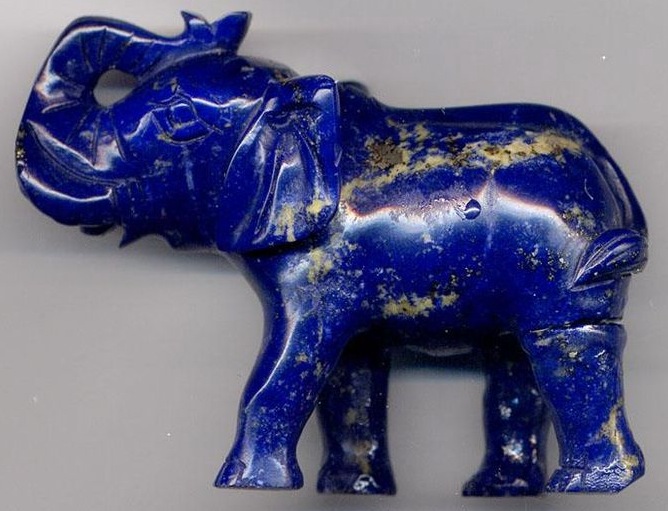Lapis Lazuli
Lapis Lazuli is a famous semi-precious stone renowned for its rich azure blue color, with flecks of gold and sometimes veins of white. Lapis lazuli has a glorious past; having been mined and used as a decorative gemstone since at least 4,000 B.C. It's said that the people of the ancient Biblical city of Ur traded in lapis lazuli in the fourth millennium B.C. [1] It was also prized by the ancient Egyptians and has been found in objects from the IVth dynasty (2613-2494 BC) onwards. [2]

Lapis Lazuli
Lapis lazuli derives its name from the old Persian word for blue - lazward [3] , or the Arabic azula, which have the same linguistic roots; and "lapis" is the latin word for "stone".
Lapis lazuli is a composite stone, made up of more than one mineral: The blue is lazurite (not to be confused with azurite, a separate mineral); the white is calcite and the gold is pyrite. Lazurite is a tectosilicate, with the chemical formula (Na,Ca)8(AlSiO4)6(SO4,S,Cl)2 [3]
The most highly prized lapis lazuli is a deep, rich, pure blue with gold flecks, such as in the carved Lapis Lazuli elephant in the upper picture; the azure areas are finely grained, with golden sparkles and with a minimum of white calcite veins or green / dark grey patches. Lapis ranges widely in quality, and the finest quality stone is uncommon, occurring in fewer places, and is much more highly priced.
The finest Lapis Lazuli is said to come from the Hindu Kush; from the ancient mines of the Badakhshan province of Afghanistan [4] . The Sary-Sang or Sar-I-Sang mine in Badakhshan is still the leading producer of lapis lazuli [5] - but the mineral is also found in Russia, the Andes, Burma, Canada, Chile, Italy and the USA. [6] Price varies widely depending on the quality / richness of color. It is a slightly softer rock than many gemstones and so lends itself well to carving - but is known to give off an unpleasant smell when being worked (presumably from the sulphur content). Lapis Lazuli is still worked by hand by skilled craftspeople in workshops in Afghanistan, and it is from there that many of the worlds carved Lapis Lazuli objects originate.
Lapis lazuli has also been revered as a magical or "holy" stone in the past. It's no wonder that this stone was considered precious, even to have magical powers: Its startling blue, with sparkles of gold, must have been particularly striking and highly desirable in ancient times before the advent of modern synthetic pigments. It's easy to make a comparison between the stone's surface and a deep blue evening sky with golden stars: With such celestial colors, Lapis is bound to acquire mystical associations.
Prior to the invention of modern blue pigment in 1834, Lapis Lazuli was the only source of ultramarine blue available to artists. The stone was powdered in order to form the base for their paints and was rare and expensive. It was used in many famous ancient paintings, and was even said to have been used by Cleopatra as eyeshadow [1]. What's interesting is that although modern colors fade through time, blue made from Lapis Lazuli is just as brilliant as ever in hue. Another stone used for blue coloring in ancient times was azurite - however this is more prone to fading on exposure to air, light or heat.
Lapis Lazuli Images

Lapis Lazuli
Lapis Lazuli - Sources Referenced:
[1] http://www.gemstone.org/gem-by-gem/english/lapis.html
[2] http://www.jstor.org/pss/4199837
[3] http://en.wikipedia.org/wiki/Lazurite
[4] http://en.wikipedia.org/wiki/Badakhshan
[5] http://afghanistan.blogs.cnn.com/2010/08/19/lapis-lazuli-afghanistans-blue-treasure
[6] http://www.mindat.org/min-2330.html
Back to the Gemstones List home page - over 160 gemstones explored!
Please feel free to link to this page - copy / paste the text below: (click to select)
Privacy Policy | Cookie Policy | GDPR | About This Site / Terms

© gemstoneslist.com


